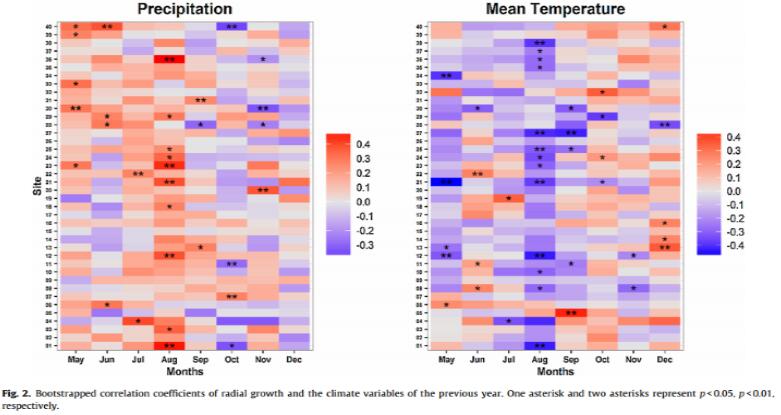Many studies have already addressed the existence of unstable and nonlinear relationships between radial growth of white spruce (Picea glauca) and climate variables in boreal forests along the high latitudes (>60°?N). However, along the mid-latitudes, the climate-growth relationship is still poorly understood.
In a recently published study, Professor Huang Jianguo (correspondence, Forest Ecology and Simulation Research Group, South China Botanical Garden, Chinese Academy of Sciences) and his cooperators used a network of ring-width chronologies from 40 white spruce sites along a wide latitudinal gradients from 52° N to 58° N in Alberta, Canada, to try to understand the complicated response of tree growth to climatic variables and to identify the main limiting factor for the radial growth of white spruce.
In this research, the empirical linear statistics were combined with the process-based Vaganov-Shashkin Lite (VS-Lite) model requiring only latitude, monthly mean temperature, and monthly total precipitation information together to better clarify growth-climate relationship. The linear statistical methods indicated that the previous summer temperature imposed a strong negative impact on the radial growth of white spruce while the precipitation and climate moisture index in prior and current summer both had significant positive effects on the radial growth. Similarly, the VS-Lite model showed that the radial growth of white spruce was limited by soil moisture. This suggests that temperature-induced drought is the main limiting factor for the radial growth of white spruce. Furthermore, climate-growth relationship varied along different elevations, latitudes, and growing degree days (GDD?>5 °C). The radial growth of white spruce in northern stands was often more strongly limited by temperature-induced drought due to the higher temperature and lower precipitation. As the global climate change is in progress, they suggest that more large-scale and continuous investigations should be done to clarify the spatial variation of growth-climate relationship.
This research is published inAgricultural and Forest Meteorology(IF: 4.461,2016, Forest, Top 1). This research was primarily funded by the 100 Talents Program of the Chinese Academy of Sciences [CAS project number Y421081001], National Natural Science Foundation of China [NSFC grant numbers 31550110208, 31570584], China Postdoctoral Science Foundation [grant number 2015M582433], Academy of Finland [projects numbers 1284701, 1282842, 285630], ICOS-Finland [project number 281255] and China Scholarship Council (CSC). Other funding agencies include Natural Science and Engineering Research Council of Canada, Mixedwood Management Association and Forest Resource Improvement Association of Alberta.
Read the article: http://dx.doi.org/10.1016/j.agrformet.2016.11.012

